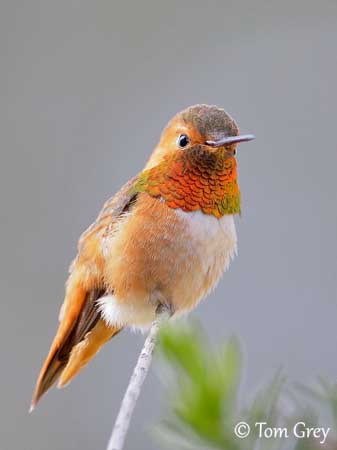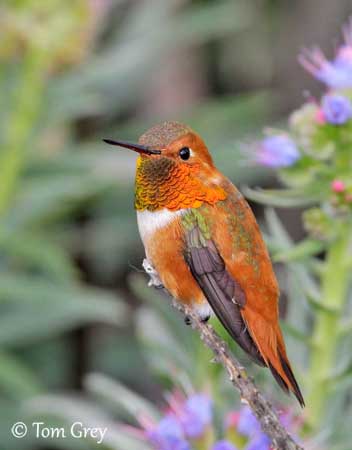
Fr: Colibri d’Allen
All : Grünrücken-Zimtelfe
Esp : Colibrí de Allen
Ital : Colibrì di Allen
Nd: Allens Kolibrie
Sd: Allens kolibri
Photographers:
Tom Grey
Tom Grey's Bird Pictures
Patrick Ingremeau
TAMANDUA
Text by Nicole Bouglouan
Sources:
A GUIDE TO THE BIRDS OF MEXICO AND NORTHERN CENTRAL AMERICA by Steve N. G. Howell, Sophie Webb - Oxford University Press - ISBN: 0198540124
FIELD GUIDE TO THE BIRDS OF NORTH AMERICA - National Geographic Society - ISBN: 0792274512
HANDBOOK OF THE BIRDS OF THE WORLD Vol 5 by Josep del Hoyo-Andrew Elliott-Jordi Sargatal - Lynx Edicions - ISBN: 8487334253
BirdLife International (BirdLife International)
Animal Diversity Web (University of Michigan Museum of Zoology)
All About Birds (Cornell Lab of Ornithology)
What Bird-The ultimate Bird Guide (Mitchell Waite)
Allen’s Hummingbird
Selasphorus sasin
Apodiforme Order – Trochilidae Family
BIOMETRICS:
Length: 8-9,5 cm
Weight: 2,5-3,8 g
DESCRIPTION:
The Allen’s Hummingbird has very restrictive range compared to the very similar Rufous Hummingbird. However, some physical differences can help us to identify both males, whereas female and immature are inseparable from the S. rufus in the field.
The Allen’s Hummingbird adult male has similar plumage that the Rufous Hummingbird, but back, scapulars and crown are iridescent green, whereas S.rufus has rufous similar zones, with only a few green feathers.
On the wings, flight feathers are blackish. The tail is rufous with black-tipped rectrices.
On the underparts, the gorget is bright red-orange, breast and neck sides are white. We can see some rufous tinge on belly, body sides and undertail-coverts, whereas thighs are white.
On the head, forehead, crown and centre of the nape are iridescent green. There is an elongated dark rufous patch from lores, through the eye and ear-coverts, extending to the sides of the nape.

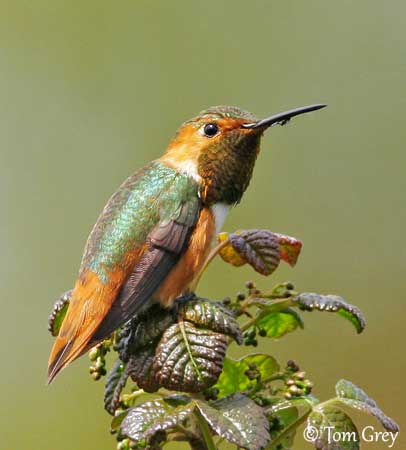
The female has iridescent greenish-brown plumage on crown, scapulars and back. Wings are blackish. Uppertail-coverts are rufous. On the tail, central rectrices are metallic green and outer rectrices are rufous with green and black subterminal patch and white tips.
The underparts are mostly white with rufous body sides and undertail-coverts. Chin and throat are white with scattered rufous and green spots. Breast and neck sides are white.
On the green head, lores show pale rufous wash extending towards the eye in more or less dark tone. There is a white postocular spot too.
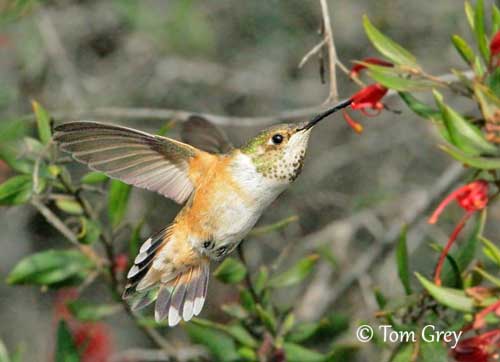
Immature resembles female, but it has rufous uppertail-coverts, and rufous bases to central rectrices.
We can find two subspecies:
S.s. sasin (here described and displayed) is found in coastal W USA, from extreme S Oregon to California, S to Santa Barbara County. This race winters in SC Mexico.
S.s. sedentarius occurs on islands off coasts of S California. This race is slightly larger than nominate. The male shows reduced black tips on tail. The female has greener rectrices than nominate, and larger white tips on outer tail feathers.
VOICE: SOUNDS BY XENO-CANTO
The Allen’s Hummingbird utters sharp chips “zeeee-chuppity-chup” much like S. rufus. We can also hear a low “chup” and buzzy calls. Adults produce a high, buzzy trill too.
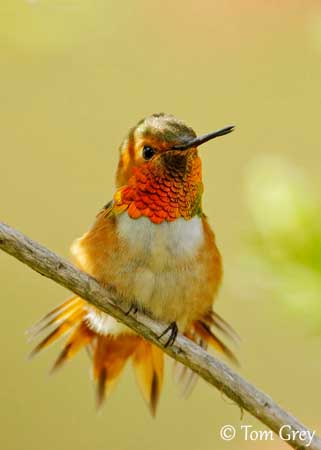
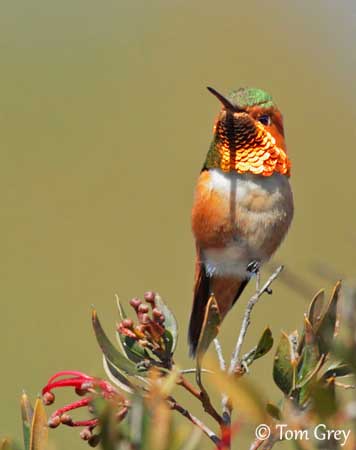
HABITAT:
The Allen’s Hummingbird frequents scrubland, coastal chaparral and bushy slopes, and can be seen in open woodland and forest edges.
The nominate race Sasin remains in humid canyons and ravines along the coast during the breeding season. In summer, it starts slowly a southwards migration and reaches the slopes of the Sierra Nevada in deciduous and coniferous vegetation.
The race Sedentarius does not migrate, and remains in scrubby canyons and ravines all year round.
RANGE:
See above in “subspecies”
BEHAVIOUR:
The Allen’s Hummingbird feeds mainly on nectar from flowers of native plant species, but also of introduced ones such as Myrtaceae, Eucalyptus and Erythrina. It hawks insects in the air too.
Like all Trochilidae species, it has a long tongue allowing the bird to get nectar from flowers.
It may consume about twice its weight in nectar each day, and may visit up to 1000 flowers per day.
Male and female defend separate feeding areas.
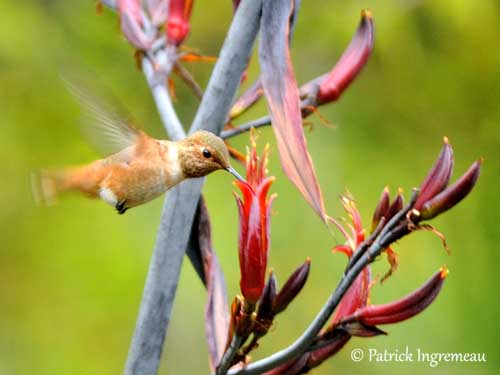
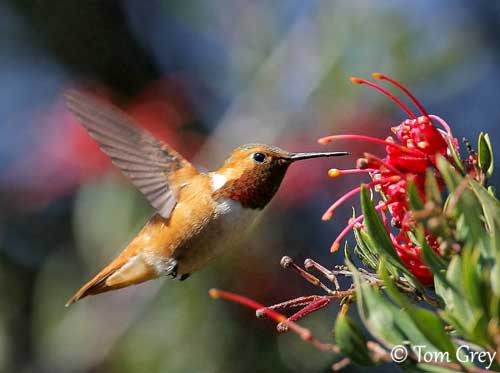
At the beginning of the breeding season, the female visits male territories, and the owner is usually aggressive towards her. But later, it engages in aerial displays, performing a J-shaped flight which is a good visual signal for the female. During these displays, the male may fly up to 23 metres height and then, it comes down and up again about 7 metres above the ground, forming a perfect J. It also performs a back-and-forth flight similar to a pendulum. At the highest peak of the arc, the male produces a prolonged buzz.
Then, both adults reach the female’s feeding area prior to copulation. After mating, the male returns to its own territory.
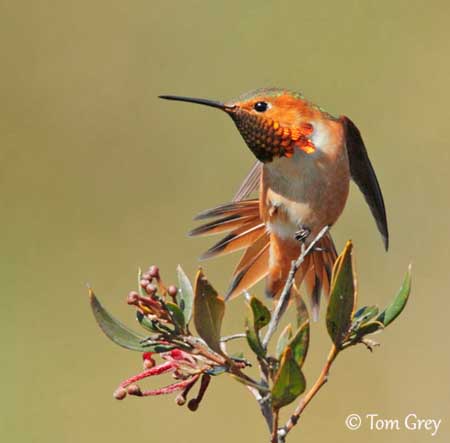
Like other hummingbirds, the Allen’s Hummingbird’s body goes into a state of torpor during the night. It remains motionless to conserve the energy. This state ends at sunrise, when the body temperature is going up.
FLIGHT:
The Allen’s Hummingbird performs beautiful aerial displays. When feeding, it can fly up and down and side to side, thanks to the fast 8-shaped wingbeats.
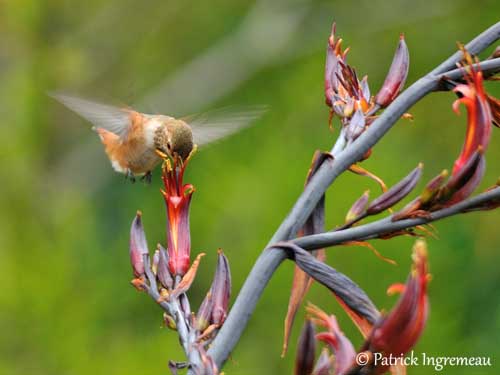
REPRODUCTION:
The Allen’s Hummingbird breeds between February and July.
The female builds the nest before mating, and finishes it after the copulation.
The tiny cup-shaped nest is made with moss, lichens, plant down, animal hair, spider webs and other fine materials. It is built outside the male’s territory, and placed on branch of tree, between 50 centimetres and 15 metres above the ground.
She lays two eggs and incubates alone during 16-22 days. The female performs all the nesting duties and protects, broods and feed the chicks until they leave the nest. She feeds them by regurgitating food from her crop. The chicks fledge about three weeks after hatching, and are immediately independents.
This species produces one or two broods per season.
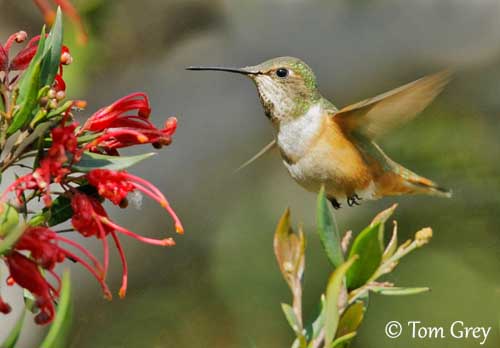
DIET:
The Allen’s Hummingbird feeds on nectar from flowers, both from native plant species and introduced ones. It also hawks insects in the air.
PROTECTION / THREATS / STATUS:
The Allen’s Hummingbird has restricted range, but the species is fairly common in its habitat in canyons and scrub habitat along the California coast. Potential threats include habitat loss, use of pesticides and extend of invasive plant species.
